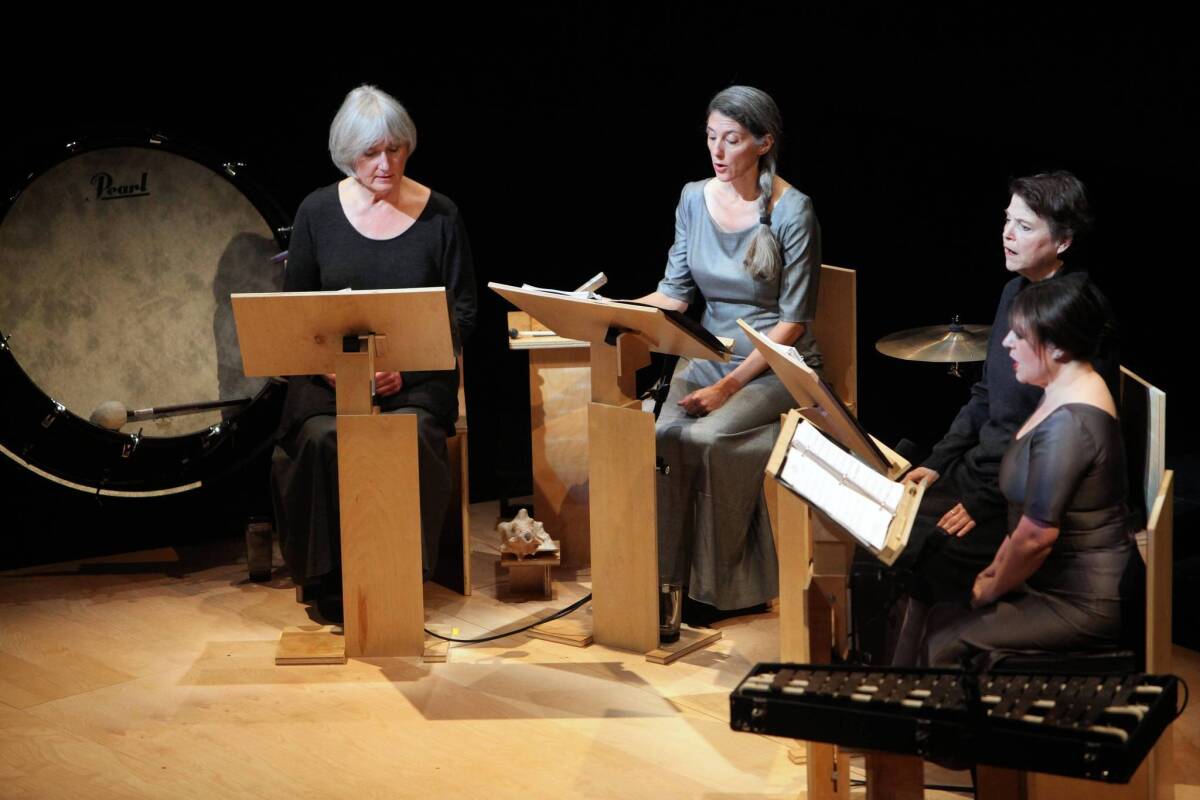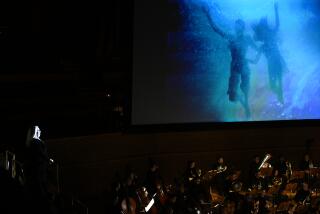Music review: How David Lang’s ‘love fail’ succeeds sublimely

For more than 20 years, David Lang, a founder of the forever feisty new music collective Bang on a Can, has used a quote in his bio from me, saying that there is no name for his kind of music. I was referring to the engagingly provocative, irreverent and unpredictably outlier spunk found in his works at the time.
The world catches up with rebels, and the now-55-year-old Lang is inevitably a little less outlier. He holds a Pulitzer Prize and a professorship at Yale. Musical America has crowned him its 2013 composer of the year, and last week Carnegie Hall named him composer in residence for the 2013-14 season.
Lang’s latest major work, “love fail,” a Postmodern take on the Tristan and Isolde legend written for the forever popular Anonymous 4, reached Royce Hall on Saturday night, UCLA’s Center for the Art of Performance having helped commission it. There is, if not perhaps a name, at least a commonplace description for this uncommon music: sublime beauty.
PHOTOS: Arts and culture in pictures by The Times
The hourlong work consists of a dozen short sections with texts by Lang and the contemporary writer Lydia Davis that take their impetus from medieval poets and also a bit from Wagner.
Words and music do an excellent job of casting a spell. UCLA did its pensive part by selling only alternate seats in Royce, thus giving each member of the audience personal space. But in case a listener didn’t quite achieve a state of contemplative mysticism, fine lighting, costume and sound design were brought in to help. More about the pretentious video later.
Lang’s look at love is mature and slightly detached yet full of feeling. His exquisite vocal writing is homophonic and uses open harmonies that are somewhat reminiscent of Arvo Pärt’s spiritual Minimalism. He exalts in the purity of tone that is the angelic trademark of Anonymous 4 (Ruth Cunningham, Marsha Genensky, Susan Hellauer and Jacqueline Horner-Kwiatek).
But there is also a typical underlying Langian subversion to “love fail.” The sources are wide, even including a touch of wisdom from the Yom Kippur liturgy. The new texts, and especially those by Davis, are musically aphoristic, and float gracefully on Lang’s languidly long melodic lines.
The composer says in his program note that he was drawn not to the Wagnerian romanticism of the Tristan tale but to the weird stuff found in the writers of yore. Lang’s lovers don’t drink operatic love potion, for instance, but a cup of everlasting sorrow.
Ecstasy cools and love, “love fail” seems to say, has failure built in. But strength of character helps love last longer, as does remaining relevant. Lang thanks Google Translate for help with searching out texts on the Internet, and that becomes his metaphor for the way modern love, itself, accepts translation.
PHOTOS: Arts and culture in pictures by The Times
Where “love fail” fails, though, is on stage.
Lang’s wife, the artist Suzanne Bocanegra, designed the suitably handsome muted gowns for the singers. Jennifer Tipton was responsible for the thoughtful lighting. Jody Elff’s sound design occasionally overused echo but was otherwise highly flattering to high women’s voices. Angelic, indeed, Anonymous 4, in great form after more than a quarter-century, sounded as though it hovered over the hall.
But the singers themselves seemed oddly uncomfortable onstage. They had a few percussion instruments to play and did so awkwardly. Jim Findlay’s video loomed portentously behind the ensemble, visually overpowering them. An artist who has shown a fine wit and weirdness in his work with the Wooster Group and Ridge Theater, Findlay here projected heavily made-up, immobile lovers staring self-consciously into the camera, looking like a cheap Bill Viola knockoff.
Lang once wrote the score to a film, “Untitled,” that parodies the art world. I kept flashing on that seeing Findlay’s art world hipsters with their Hollywood look.
If love, like life, fails, our job is, through generosity of spirit, to at least prolong it. And “love fail” will last longest through its wondrous music and moving words.
MORE
INTERACTIVE: Christopher Hawthorne’s On the Boulevards
TIMELINE: John Cage’s Los Angeles
PHOTOS: Arts and culture in pictures
More to Read
The biggest entertainment stories
Get our big stories about Hollywood, film, television, music, arts, culture and more right in your inbox as soon as they publish.
You may occasionally receive promotional content from the Los Angeles Times.











